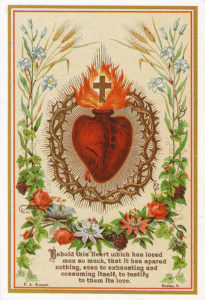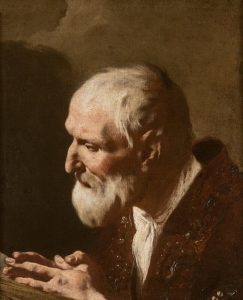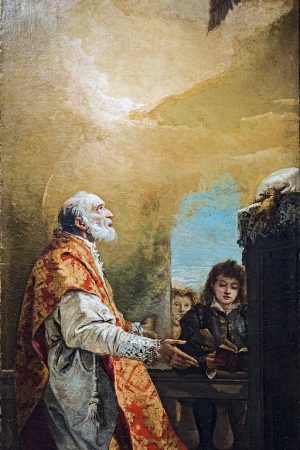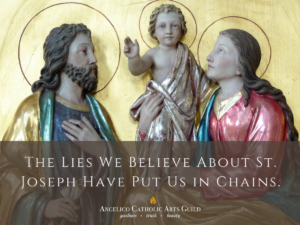Art Can Save Our Eucharistic Faith
- Post author:Katie Lovett
- Post published:June 11, 2021

Art Can Save Our Eucharistic Faith…with a Little Help from the Sacred Heart
In the Catholic Church, we have something that no one else has–we have the literal Heart of Jesus in our midst. At every visit to Adoation, every Mass, and especially every Communion, we don’t just encounter Jesus’ prophecies, teachings, or a touchy-feeling experience that can be manipulated through catchy music or spurred by an inspired message. We become one with the Maker of all things when we consume the Heart of our God.
And that’s exactly how He wants it.
Now, this isn’t the sort of wording that will bring people to our parishes in droves. The idea of eating human flesh–even Divine Flesh–tends to make people run the other way. That is, unless they understand the depth, breadth, bliss, and life that permeate this precious reality.
God Himself gives us His own body to nourish us, because without the food that is Jesus, we cannot live. You and I know that, and we see the beauty of that truth. But the rest of the world isn’t ready for that yet.
That’s where the Sacred Heart comes in.
And it’s where you come in, too.
Your Mission, Should You Choose to Accept It
The visual image we know as the Sacred Heart of Jesus–with its flames, cross, crown, and wounded side–was given to St. Margaret Mary Alacoque by Jesus Himself precisely to make His Heart accesible to those not ready for the reality of the Eucharist. It was given to non-Catholics, yes, but it was given even more to the members of the Church. Because just being Catholic doesn’t mean we have Eucharistic faith.
We live in a time when most of the people we need to evangelize are our own. The faithful are leaving the Church en masse, and 75% of the ones still standing don’t believe in the True Presence. They don’t believe that the God of all things has plunged Himself into our messy world and scandal-ridden Church. They don’t believe He desires any part of our brokenness.
Lies. All of them.
Jesus Christ has stepped down from Heaven to walk among men of clay and turn them into Himself. It’s a truth too spectacular for many to reconcile with what we know of ourselves. The only way the Church or the world can accept the truth of the Eucharist is if someone makes it palatable for their earthly sensibilities.
Jesus did that. He gave the Church–and the world–His Sacred Heart. And…he gave the Church artists who could paint it, sing of it, write about it, and etch it in stone.
You and I, my friends, are artists. And that means we have God’s work to do. That means we must, with a zeal and devotion unsurpassed, take up the mission of the Sacred Heart.

What is the Mission of the Sacred Heart?
Before we can take up the Sacred Heart’s mission as artists, we must take it up as Catholics first and foremost. So what is the mission of the Sacred Heart?
For our purposes, the Sacred Heart’s mission has two basic parts: the 12 promises Jesus gives to those who honor his Sacred Heart, and the symbolism within the image.
The 12 Promises of the Sacred Heart
Jesus gave these promises to St. Margaret Mary Alacoque for those who practice devotion to His Sacred Heart:
- I will give them all the graces necessary in their state of life.
- I will establish peace in their homes.
- I will comfort them in all their afflictions.
- I will be their secure refuge during life and, above all, in death.
- I will bestow abundant blessings on all their undertakings.
- Sinners will find in My Heart the source and infinite ocean of mercy.
- Lukewarm souls shall become fervent.
- Fervent souls shall quickly rise to great perfection.
- I will bless every place in which an image of My Heart is exposed and honored.
- I will give to priests the gift of touching the most hardened hearts.
- Those who promote this devotion shall have their names written in My Heart.
- I promise you in the excessive mercy of My Heart that My all-powerful love will grant to all those who receive Holy Communion on the First Fridays in nine consecutive months the grace of final perseverance; they shall not die in My displeasure nor without receiving their Sacraments. My divine Heart shall be their safe refuge in this last moment.
The first step in taking up the mission of the Sacred Heart is to write it on our own hearts and live it out in our everyday lives. It’s no use fretting about the Church’s lack of faith in the Eucharist when we’re not maintaining that faith in ourselves. Too often, we can develop a commonplace attitude about the Eucharist, a casual irreverence that comes when we take the True Presence for granted. Plenty of us profess belief in the True Presence but decline when we’re given the opportunity to attend daily Mass and participate in the re-presentation of Christ’s sacrifice, to receive His Body, Blood, Soul, and Divinity in Communion. If Christ in the Eucharist isn’t the center of our own lives, how can we be convincing when we tell others that He should be the center of theirs?
Granted, many of us aren’t able to attend Mass every day, or even every First Friday. But if we find that our own Eucharistic faith needs a shot of espresso, we can’t go wrong by starting with the final and most important Sacred Heart promise. We can’t go wrong by making every effort to come to Mass on First Fridays for the next nine months…or even beyond.

The Symbolism Within the Sacred Heart
We’ve all seen the Sacred Heart image, but have you thought about the elements that make it up? Each aspect has a specific meaning that leads to one inevitable conclusion: Jesus’ Heart burns with love for you and me.
- Jesus’ Heart is on fire with love for all mankind, and the flames bursting from and engulfing His Heart represent His always, everlasting, and blazing love.
- The cross reminds us of Christ’s Passion and Death–evidence of the depth of His love.
- The crown of thorns symbolizes the injuries we inflict on the Heart of Jesus when we reject His love.
- The wound reminds us of the moment when Jesus’ side was pierced and His Heart gushed forth Blood and Water, given for us out of love.
- The rays radiating from His Sacred Heart stand for the graces and blessings that flow from the fire of His love.
Every part of the Sacred Heart image is meant to remind us that Jesus’ Heart is consumed with burning, searing, white-hot love for you. For me. For all of us. It is a love that cannot be put out by our rejection, by indifference, by sin, by anything.
This is the Heart we encounter at every Mass, every Communion. The more we immerse ourselves in the symbolic imagery of the Sacred Heart, the more we cannot help but face the truth–that yes, the God of all things does desire us in our brokenness. Yes, He has plunged Himself into our midst, loving us enough to save us from ourselves. Loving us enough to not only lay down His life on the Cross, but to serve it to us in a chalice of gold.
There is raw power in the image of the Sacred Heart. That’s why it’s so important for every Catholic to have and cherish Sacred Heart images of their own. The Church has lost its Eucharistic faith? Let’s find it again. Let’s find it by seeking and sharing the Sacred Heart.
What Can Artists Do to Share the Sacred Heart?
On the surface, it’s easy to name what artists can do to share the Sacred Heart. If every Catholic–and even every person–needs to have and cherish at least one image of the Sacred Heart at home, then we need to create these images, right? The artist’s role in the mission of the Sacred Heart is to paint, draw, sculpt, or otherwise render Sacred Heart images? Simple.
Well…no. It’s a little more complicated than that.
Okay, then. Let’s broaden our reach. After all, words can promote the Sacred Heart and the ideas its image symbolizes. St. John of the Cross’ poetry spoke of Jesus’ Heart as “an open wound with love” even before St. Margaret Mary Alacoque’s visions. And can’t we sing about it? Write hymns devoted to the Sacred Heart? Promote it through theatre, even? Those are all good things.
But here’s the issue. There’s never been a shortage of artists who create art centered on the Sacred Heart. Sure, there may not be as many Catholic artists as there used to be, but there’s never been the potential for reaching people across the world, and even across cities, as there is today. If I want to find Catholic artists creating images of the Sacred Heart, a simple hastag search on Instagram will turn up a plethora of options. I can find handmade items with the Sacred Heart all over Etsy. My choices may be more limited if I’m looking for music or theatre centered on the Sacred Heart, and perhaps this needs to change. But that’s another issue entirely. Catholic artists in several disciplines are already making Sacred Heart images and other art forms that promote devotion to the Heart of Jesus.
And yet…the Church’s lack of Eucharistic faith remains.
The Church absolutely needs artists to create beautiful images, poems, songs, and so much more about the Sacred Heart, but consider this. Maybe, just maybe, the Church needs your creative brain even more. Maybe the Church needs creative Catholics to set aside their crafts for just a moment and put their artistic minds to work looking for ways to put the Sacred Heart–images, songs, and all–in the hands of the lukewarm, the fallen away, the poorly catechised, and the faithful who need new life breathed into that faith.

You Say You Want a Revolution
Can this work? Can a bunch of random artists scattered across the diocese start a Eucharistic revolution just by putting their right-brained minds to work on creative mission outreach? Why not? Isn’t that how the Angelico Project got started?
Stop what you’re doing right now and write down five ideas for how you could encourage devotion to the Sacred Heart within the next year at your parish. Don’t worry about whether they’re good ideas for now. Just brainstorm. What have you got?
Here’s my list:
- Counter Pride Month in June with a program called Summer of the Sacred Heart for upper elementary and possibly junior high. These are the age groups who watch networks like Nickelodeon and Cartoon Network and are bombarded with Pride propaganda targeting kids every June. Meet every Saturday after morning Mass in June, or even the whole summer, to make Sacred Heart t-shirts, necklaces, etc.–a different project each weekend–and discuss the love of Jesus for all people as expressed in the Sacred Heart.
- Have a painting party for the parish, similar to Painting with a Twist, and everyone can paint a Sacred Heart image to display in their homes. (This, by the way, is completely doable. I did this with two second graders a couple months ago, so adults can definitely handle it!) Even better, incorporate this into a First Friday. Hold the painting party first, then have Mass. That way, people who wouldn’t normally stay for Mass will stick around–their painting will need to dry while Mass is going on, so they can just go to Mass and pick it up after!
- Incorporate a Sacred Heart sidewalk chalk art competition into a family parish event, and distribute holy cards with the 12 Sacred Heart promises to all participants.
- Write a play about St. Margaret Mary Alacoque for the parish youth.
- Have a parish or school holy card competition similar to the one just held by the Angelico Project for the Marian pilgrimage. Call for works that promote devotion to the Sacred Heart, and winners will be printed on holy cards featuring a Sacred Heart prayer and distributed to parishioners.
Your ideas are likely to be very different from mine, depending on your role in the life of your parish. That’s an awesome thing. We need Sacred Heart devotion in every corner of the Church. If all of us brainstorm, bounce ideas off each other, and place the Eucharistic Heart front and center in our own lives, there’s no telling how fast the fire of faith will spread.
But we have to do it! And we have to start now.
The Eucharistic Revolution Begins with You
Start now. But where? How?
First, we need to shore up our own Sacred Heart devotion and Eucharistic faith. Are we attending Mass on First Fridays when able? Do we display the Sacred Heart in our homes or workplaces? Do we encourage others to practice devotion to the Sacred Heart–with or without our art being involved?
Are we as reverent as possible when we genuflect? When we receive the Eucharist? No matter who we are, each of us needs to spend time simply being in awe of the Eucharistic Heart of Christ every day. Nothing else we do will matter if we don’t start with ourselves.
Second, let us again take a lesson from St. Louis de Montfort. In order to spark Eucharistic faith in mainstream Catholic culture, we need to enter it. We need faithful Catholics devoted to the Heart of Jesus in parishes where the lukewarm and heterodox congregate.
Are you in such a parish? You’ve got your work cut out for you, but take heart. You’re not alone. Are you not in such a parish but know faithful Catholics who are? Pray for them and be their sounding boards. These are the people in the trenches–America’s modern missionaries. They need to be reminded that they’re not isolated in their faith.
Third, regardless of the parishes God has placed us in as Catholics, as artists with creative, quirky minds, we need to come together to discuss ideas that might just be crazy enough to work. That list of five ways to promote the Sacred Heart you just made? Don’t keep it to yourself. Talk to other Catholic creatives. Get their feedback, give feedback of your own, and even combine your efforts and ideas to start something amazing.
Let’s band together to share with the Church–and the world–our most precious treasure, one that can be found nowhere but in the Catholic Church. Let’s unite our scattered selves and varied artistic disciplines to the Heart that lives in every tabernacle across the world. Let’s become one in our unquenchable desire to never stop promoting the Sacred Heart until every soul burns with faith in our Eucharistic Lord, who feeds us with His very Self.
Because that’s exactly how He wants it. And that’s the only thing we need to know.








 “No one, after lighting a lamp, hides it under a jar, or puts it under a bed, but puts it on a lampstand, so that all who enter may see the light.”
“No one, after lighting a lamp, hides it under a jar, or puts it under a bed, but puts it on a lampstand, so that all who enter may see the light.” 







 Lie #3: “St. Joseph’s marriage to Mary was nothing more than a legal contract.”
Lie #3: “St. Joseph’s marriage to Mary was nothing more than a legal contract.” Catholic Artists are St. Joseph’s Standard Bearers
Catholic Artists are St. Joseph’s Standard Bearers Spiritual Treasures Guaranteed or Your Money Back
Spiritual Treasures Guaranteed or Your Money Back Are You Ready to Be a Warrior for St. Joseph?
Are You Ready to Be a Warrior for St. Joseph?